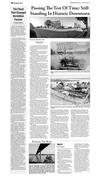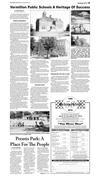112015_YKPT_B3.pdf




November 20, 2015 www.plaintalk.net
Heritage 2015
3B
Transportation In Early Vermillion
Compiled From historical Plain Talk Issues
STEAMBOATS REACH
VERMILLION
PLAIN TALK FILE PHOTO
Spirit Mound, pictured here with flowers in full
bloom is a wonderful place to visit with a parking
and picnic area, restroom and a walking trail
leading to the top of the mound from which hikers
can stand where Lewis and Clark did so many
years ago.
The Spirit Mound:
A Local Legend
BY SARAH WETZEL
For the Plain Talk
To an average person
driving past the Spirit
Mound on Highway 19 five
miles north of Vermillion it
might seem they are passing
a simple hill when, in fact,
the geographical anomaly
has held special significance
throughout South Dakotan
history.
The hill was known by
the Sioux as Paha Wakan
and was a center of high superstition as discovered by
Lewis and Clark when they
traveled through the area.
As quoted on www.spiritmound.com, Clark recorded
in his journal the following:
“Capt Lewis and my Self
Concluded to visit a High
Hill Situated in an emence
Plain three Leagues N. 20º
W. from the mouth of White
Stone river, this hill appear
to be of a Conic form and by
all the different Nations in
this quater is Supposed to
be a place of Deavels or that
they are in human form with
remarkable large heads and
about 18 inches high; that
they are very watchfull and
ar armed with Sharp arrows
with which they can kill at
a great distance; they are
said to kill all persons who
are so hardy as to attemp to
approach the hill; they state
that tradition informs them
than many indians have suffered by these little people
and among others that three
Maha men fell a sacrefice
to their murcyless fury not
meany years since- so much
do the Mahas Souix Ottoes
and other neibhbouring
nations believe this fable
that no consideration is
sufficient to induce them to
approach this hill.”
Curiosity was sufficient
to induce Lewis and Clark to
hike nine miles out of their
way to visit the site and
climb to the top of the hill.
Today if history buffs
wish to travel the approximate course that Lewis and
Clark did, beginning at Cotton Park in Vermillion, take
Dakota Street north, then
Main Street west to Stanford
Street / Hwy 19 and continue on it six miles to Spirit
Mound.
Clark wrote again in his
journal about the view from
the summit.
"from the top of this
Mound we beheld a most
butifull landscape; Numerous herds of buffalow were
Seen feeding in various
directions, the Plain to the
N. W & N E extends without
interuption as far as Can be
Seen- … no woods except
on the Missouri Points…
if all the timber which is
on the Stone Creek [Vermillion River] was on 100 a[c]
res it would not be thickly
timbered, the Soil of those
Plains are delightfull."
The Dakota Territory
was created by the U.S.
government in 1861 after
the Yankton Sioux moved to
a reservation 70 miles West
and the first homestead was
filed on the Spirit Mound
area in 1868.
Throughout the years
of agriculture and various
forms of cultivation the
area lost its original natural
beauty that awed Lewis and
Clark.
“Preservation and restoration also came slowly
to the mound,” reads the
history on spiritmound.
com. “Local efforts placed it
on the National Register of
Historic Places in 1974 and
in 1986 a local group incorporated the Spirit Mound
Trust, dedicated to saving the mound as a public
resource.”
The restoration is currently headed by the Spirit
Mound Trust, dedicated
to the goal of restoring the
area to the way it was when
Lews and Clark set foot
there 200 years ago.
Preservation has included seeding the area with
natural prairie plant species
which in turn invite the
wildlife back to the area.
“There are many challenges,” the website reads.
“We must encourage the
remnants of the original
prairie to proliferate, halt
the growth of invasive
species and introduce additional native species at
appropriate sites.”
Now a state park the
Spirit Mound is a wonderful
place to visit with a parking
and picnic area, restroom
and a walking trail leading
to the top of the mound
from which hikers can stand
where Lewis and Clark did
so many years ago.
On the way signs mark
various species of plants
native to the prairie.
The history of the mound
SPIRIT | PAGE 4B
Clay County
Historical Society Presents
‘Twas the Night
Before Christmas!
TOUR of HOMES
Friday, December 4, 2015
4:30 - 7:30 p.m.
Tickets - $15
Available at the Austin-Whittemore House,
Nook ’n Cranny, and Vermillion Beauty Shop
RIDES AVAILABLE - LIMITED NUMBER OF SEATS
Sponsored by Vermillion Public Transit
For more information call: Clay County Historical Society @ 605.624.8266
Merry Christmas to all, and to all, a good night!
With its location on the Vermillion and Missouri Rivers, steamboat
navigations was destined to come
to Vermillion. Even though it started
slowly by 1864 steamboat travel was
in full gear.
Nearly 50 vessels were reported
that year alone. During the next 15
years, the number of boats steadily
increased to 75 boats plying the river
from Sioux City and Yankton to Fort
Benton and stops along the way.
The large number of boats on the
water and the natural shallowness of
the river signaled that accidents were
destined to happen.
The sternwheeler North Alabama,
a well-built craft with good speed,
enjoyed many successful trips before
snagging on the Missouri. One of the
most daring trips undertaken by veteran pilot, Captain Grant Marsh, was
aboard the North Alabama.
On Oct. 1, 1869, the vessel left Sioux
City for the forts on the upper Missouri to deliver perishable vegetables
to the military garrisons. Also aboard
the vessel was Major Bannister, the
military paymaster, and his clerk, Mr.
Baker. They were taking money to pay
the troops at the posts to be visited.
The warm weather held for the
journey to Forts Randall, Hale, Sully,
Rice and Stevenson. The cargoes were
unloaded and the soldiers paid. Only
one fort remained – Fort Buford.
After leaving Fort Stevenson, the
air began to chill. Within a day, slush
ice was forming on the river. The
vegetables were transferred from the
main deck to the hold. Small fires
were started to keep the air warm. For
a frail wooden steamboat, this was a
daring experiment. However, no disaster resulted.
As the ice continued to form, the
North Alabama struggled on until
October 22 when the vessel was frozen
solid against the bank at the mouth of
the Little Muddy Creek.
Captain Marsh sent two Indian
scouts who had joined the party at
Fort Berthold, overland to Fort Buford
to advise the commanding officer
of the North Alabama’s situation.
Though the fort was more than 25
miles away, the next day a train of covered wagons could be seen, coming to
relieve the boat of its cargo.
The soldiers had equipped each
wagon with a small camp stove and
were able to reach the fort without
losing any of the vegetables. Major
Bannister returned to the fort to pay
off the garrison.
Ten days after the ice froze, it broke
and the river began running. Captain
Marsh sent one of the scouts back to
Fort Buford to get Major Bannister. As
soon as the two arrived back at the
boat, the North Alabama cast off and
traveled at full speed to Sioux City,
arriving there November 15.
For this successful trip, Captain
Marsh declared he received more commendations from the military than any
other work he performed.
It was less than one year later, on
Oct. 27, 1870, that the North Alabama
sank near Vermillion in what is now
known as the North Alabama Bend.
The Yankton newspaper described the
disaster as follows:
“She was going from the Dakota
shore to the Nebraska shore and about
200 yards from the latter shore, she
struck her bow on the end of a sunken
log, and went down without advancing another yard, the log knocking a
hole in her nearly eight feet long and
two feet wide, sinking her in less than
thirty minutes.”
COURTESY PHOTO: CLAY COUNTY HISTORICAL SOCIETY
The Vermillion Train Depot pictured here circa 1915 heralded the
start of the modern age according to newspaper reports at the time.
The station would open up Vermillion to easier travel and help spur
growth in town.
COURTESY PHOTO: NATIONAL
PARK SERVICE
Looking upriver toward the bow
of the North Alabama and the
snag that sank the steamboat
on the Missouri River in 1870.
The craft was valued at $12,000.
The newspaper account stated that
her cargo was 2,000 pounds of flour.
A news article from 1906, states the
steamer carried more than flour. The
July 12th issue of the New York Tribune stated:
“The river steamer North Alabama,
which was sunk in the Missouri River
six miles below here, (Vermillion)
in 1870 strangely rose to the surface yesterday and today crowds of
spectators line the banks. The boat
carried a cargo of flour and whiskey
for the Yellowstone district. The fifty
barrels of thirty-six-year-old whiskey
have attracted the lovers of good
liquor and already a scramble to find
the prize has begun. As yet it has not
been reached, owing to the quantities
of mud accumulated over the lower
decks.”
In the heyday of steamships, the
1869 season, 143 landings were made
at the Yankton levee. The navigation
of the Missouri was not seriously hampered except by sandbars during low
water. The river was free from accidents except those that were common
to streams everywhere. Steamboats
did not cease to navigate the Missouri
because of any hindrance or obstacle
to navigation.
The coming of the railroad across
the great river meant passengers and
freight could be carried quicker and
more economically. The inevitable
result was steamboats were compelled
to abandon the river.
RAILROAD HERALDS
MODERN ERA
Prior to 1872, Vermillion was a
river town that depended on sidewheeler steamboats to handle freight
and passenger traffic. Other towns in
Southeast Dakota, such as Elk Point,
COURTESY PHOTO: CLAY COUNTY
HISTORIC PRESERVATION COMMISSION.
A train leaving Vermillion in
December of 1907 carried
passengers to and from town.
received goods by horse or ox-drawn
wagons.
The nearest railroad was in Sioux
City, Iowa. Elk Point advocated the
construction of the Dakota Southern
from Sioux City to Yankton. Union
County voted in favor of a bond issue
to finance the railroad.
Vermillion residents apparently
reasoned that if the Dakota Southern
ran from Sioux City to Yankton, it would
have to go through Vermillion. Recalling railroad bond swindles in the eastern states, many settlers were against
a bond issue. When brought before the
people for a vote, the $80,000 bond proposal failed when 762 of the 825 voters
cast negative ballots.
The officials of the Dakota Southern
accepted the defeat in Clay County.
They required that the local businessmen donate 150 city lots to the railroad,
procure a free right-of-way through the
county and raise $4,000 for a depot
building.
These demands brought bitterness
when owners of the right-of-way received no compensation for their land.
Eventually all the requirements were
met and the Dakota Southern arrived in
Vermillion on Dec. 2, 1872.
The local newspaper, the Dakota Republican, reported: “A new era dawned
upon Vermillion …we are in the World
again. We have not fully comprehended
and realized it, but it is true, nevertheless – Good-bye stagecoaches, slow
journeys, tedious rides, and dread of
trips away from home! Good-bye the
Frontier and All-Hail Civilization, which
had found us again!”
“The first passenger train was put
on the road and carried the mail both
ways between Sioux City, IA, and Vermillion. Last Monday will henceforth
be to our town the most prominent and
important epoch of all its history.”
“Welcome to the locomotive, and
may we never get ahead of it again.”

















 Previous Page
Previous Page






